Zoom
Trash

NIBBANA. Nibbana - By Bikkhu Bodhi The Buddha says that he teaches only Dukkha and the cessation of Dukkha, that is, suffering and the end of suffering.
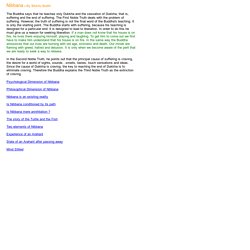
The First Noble Truth deals with the problem of suffering. However, the truth of suffering is not the final word of the Buddha's teaching. It is only the starting point. The Buddha starts with suffering, because his teaching is designed for a particular end: it is designed to lead to liberation. Wings to Awakening: An Anthology from the Pali Canon. Into the Stream: A Study Guide on the First Stage of Awakening. Introduction The Pali Canon recognizes four levels of Awakening, the first of which is called stream entry.
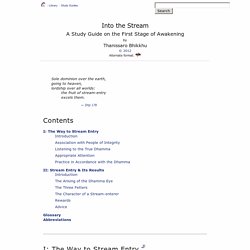
This gains its name from the fact that a person who has attained this level has entered the "stream" flowing inevitably to nibbana. He/she is guaranteed to achieve full awakening within seven lifetimes at most, and in the interim will not be reborn in any of the lower realms. This study guide on stream entry is divided into two parts. PDF Documents. Dreadlockstory. Kagyu Monlam Chenmo. Morning Prayer by the Dalai Lama. Words of Truth by the Dalai Lama. WORDS OF TRUTH A prayer composed by HIS HOLINESS TENZIN GYATSO THE FOURTEENTH DALAI LAMA OF TIBET Honoring and invoking the Great Compassion of the Three Jewels: the Buddha, the Teachings, and the Spiritual Community WISDOM PUBLICATIONS BOSTON First published, 1993 Copyright 1993 His Holiness the Dalai Lama All rights reserved.
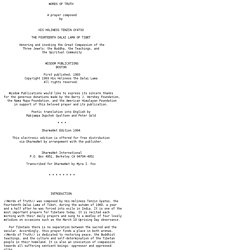
Wisdom Publications would like to express its sincere thanks for the generous donations made by the Barry J. Hershey Foundation, the Nama Rupa Foundation, and the American Himalayan Foundation in support of this beloved prayer and its publication. Poetic translation into English by Rabjampa Dupchok Gyaltsen and Peter Gold * * * DharmaNet Edition 1994 This electronic edition is offered for free distribution via DharmaNet by arrangement with the publisher. DharmaNet International P.O. Box 4951, Berkeley CA 94704-4951 Transcribed for DharmaNet by Myra I. Tibetan Bön. YungDrung Bön is Tibet's oldest spiritual tradition, and the founder of the Bön religion is Buddha Shenrab.

He is said to have been born in the mythical land of Olmo Lung Ring, whose exact location remains something of a mystery. The land is described as dominated by Mount Yung-drung Gu-tzeg(Edifice of Nine Swastikas), which many identify as Mount Kailash in western Tibet. Due to the sacredness of Olmo Lung Ring and the mountain, both the counter-clockwise swastika and the number nine are of great significance in the Bön religion. Due to royal patronage of Indian Buddhism by Tibet's king Trisrung Detsun (7th century), Bön was discouraged and practitioners faced persecution and banishment. The Bon Foundation-About Bon. Menri (Medicine Mountain) Monastery is located in the Solan district of Himachal Pradesh, in a rather out of the way corner, far from cities and bazaars.
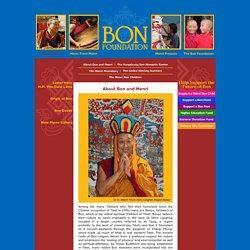
How this place has changed in recent years! From a sleepy, albeit culturally important backwater, Menri has become a bustling hub of religious learning and ritual activity. Until 1998, Menri was a very rudimentary facility with a few simple adobe and stone buildings. Even the main temple was bereft of the rich decorations that have come to characterize Tibetan religious edifices. There were around 100 monks then. Bon. What is Bon?
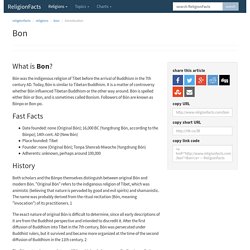
Bön was the indigenous religion of Tibet before the arrival of Buddhism in the 7th century AD. Today, Bön is similar to Tibetan Buddhism. It is a matter of controversy whether Bön influenced Tibetan Buddhism or the other way around. Bön is spelled either Bön or Bon, and is sometimes called Bonism. Followers of Bön are known as Bönpo or Bon-po. Fast Facts Date founded: none (Original Bön); 16,000 BC (Yungdrung Bön, according to the Bönpo); 14th cent. History. Living Languages. Spiritual Succor. संस्कृतम् The Existential Buddhist. I’m auditing a course on Eihei Dogen (1200-1253) that’s being taught by Taigen Dan Leighton under the auspices of the Institute of Buddhist Studies.
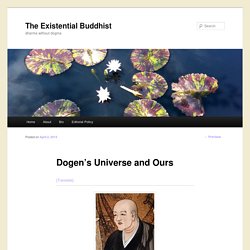
Dogen, the founding father of Japanese Soto Zen, was a prolific writer whose essays and recorded talks are, in turns, dense, perplexing, ironic, and poetic. He had an eye for imagery, an ear for language, an encyclopedic grasp of the koan and sutra literatures, and a perverse desire to torture ideas, turning them upside down and inside out until he had wrung whatever he could from them. Reading Dogen is difficult going because it’s often hard to tell when he’s being straightforward, when he’s waxing poetic, and when he’s pulling one’s leg. He’s most challenging when he’s being absolutely straightforward because he understood “time,” “space,” and “nature” as a medieval Japanese Buddhist would. For Dogen, space is equivalent to everything that has form — objects, beings, and the distances between them. Dogen offers us a seamless vision. A_Secular_Buddhist_(2).pdf.
On the Faith of Secular Buddhists « Speculative Non-Buddhism. Secular Buddhism, “like all ‘isms’…is at best a parody, at worst a constriction.”
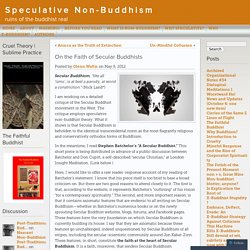
(Nick Land*) I am working on a detailed critique of the Secular Buddhist movement in the West. The critique employs speculative non-buddhist theory. What Is Secular Buddhist Practice? We often get asked by traditional Buddhist, and people of all kinds, what is secular Buddhist practice?
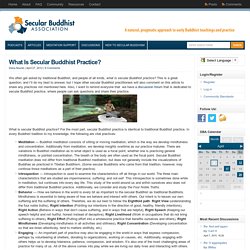
This is a great question, and I’ll do my best to answer, but I hope other secular Buddhist practitioners will also comment on this article to share any practices not mentioned here. Also, I want to remind everyone that we have a discussion forum that is dedicated to secular Buddhist practice, where people can ask questions and share their practice. What is secular Buddhist practice? For the most part, secular Buddhist practice is identical to traditional Buddhist practice. In every Buddhist tradition to my knowledge, the following are vital practices: Meditation — Buddhist meditation consists of sitting or moving meditation, which is the way we develop mindfulness and concentration. Those are the practices of secular Buddhists. Some secular Buddhists avoid rituals for various reasons, and feel all the practices I mentioned above are really what’s important in Buddhist practice. Sacred Paths. Spirits Align. Buddhist Mantras. Tibetan Buddhism Archives.
Buddhism. Mindfulness Bell. Kalama Sutta. The Buddha and His Dhamma, by Dr. B. R. Ambedkar. Land of No Buddha: Reflections of a Sceptical Buddhist. About the author In January 1967, at the age of 21, Richard Hayes attended four talks on Buddhism and a month-long seminar on the trial and death of Socrates, both at the family Unitarian Church.
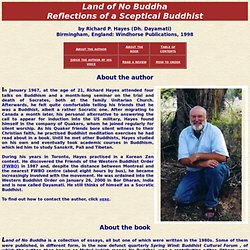
Afterwards, he felt quite comfortable telling his friends that he was a Buddhist, albeit a rather Socratic one. After migrating to Canada a month later, his personal alternative to answering the call to appear for induction into the US military, Hayes found himself in the company of Quakers, whom he joined regularly for silent worship. As his Quaker friends bore silent witness to their Christian faith, he practised Buddhist meditation exercises he had read about in a book. Until he met other Buddhists, Hayes studied on his own and eventually took academic courses in Buddhism, which led him to study Sanskrit, Pali and Tibetan. During his years in Toronto, Hayes practised in a Korean Zen context.
To find out how to contact the author, click here. About the book Contents1. 1 On Being Dharma-centric. What is a Secular Buddhist, and What Do They Believe? A few months back I addressed the question we were receiving frequently What is Secular Buddhist Practice? Now, we are seeing stereotypes of secular Buddhists cropping up, and some assumptions about the beliefs or lack thereof regarding secular Buddhists. I’d like to address both questions in one article, because they tend to roll into one another in conversations. Drop of Dhamma Delight! Detached from Bodily and Mental Feeling! The Blessed Buddha once said: Bhikkhus, the uninstructed ordinary personfeels pleasant feelings, painful feelings, and neither-painful-nor-pleasantfeelings... Such does the instructed Noble Disciple also feel.
Dhamma Drop Index II. NTI Buddhist Text Reader. Understanding Buddhist Sanskrit Terms Contents Introduction This document is intended to give the reader some understanding of Sanskrit terms and text, primarily relating to Buddhism.